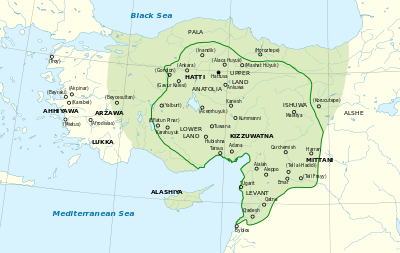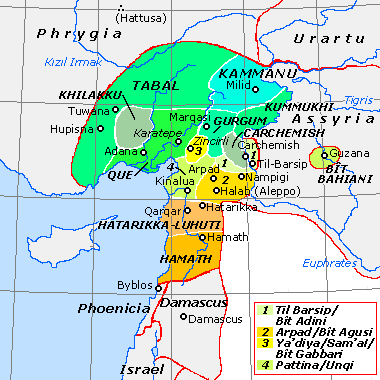Syro-Hittite states
Part of a series on the |
||||||||||||||||||||||||||||||||||||||||
|---|---|---|---|---|---|---|---|---|---|---|---|---|---|---|---|---|---|---|---|---|---|---|---|---|---|---|---|---|---|---|---|---|---|---|---|---|---|---|---|---|
| History of Turkey | ||||||||||||||||||||||||||||||||||||||||
 | ||||||||||||||||||||||||||||||||||||||||
|
||||||||||||||||||||||||||||||||||||||||
|
||||||||||||||||||||||||||||||||||||||||
|
||||||||||||||||||||||||||||||||||||||||
|
||||||||||||||||||||||||||||||||||||||||
|
||||||||||||||||||||||||||||||||||||||||
| Timeline | ||||||||||||||||||||||||||||||||||||||||
| Turkey portal | ||||||||||||||||||||||||||||||||||||||||
The states that are called Neo-Hittite, or more recently Syro-Hittite were Luwian-, Aramaic- and Phoenician-speaking political entities of the Iron Age in northern Syria and southern Anatolia that arose following the collapse of the Hittite Empire around 1180 BC and which lasted until roughly 700 BC. The term "Neo-Hittite" is sometimes reserved specifically for the Luwian-speaking principalities like Milid and Carchemish, although in a wider sense the broader cultural term "Syro-Hittite" is now applied to all the entities that arose in south-central Anatolia following the Hittite collapse—such as Tabal and Quwê—as well as those of northern and coastal Syria.[1]
Late Bronze Age-Early Iron Age transition

The collapse of the Hittite Empire is usually associated with the gradual decline of Eastern Mediterranean trade networks and the resulting collapse of major Late Bronze Age cities in the Levantine coast, Anatolia and the Aegean.[2] In the middle of the 13th century BC, great groups of Greeks speaking ancient Dorian dialects moved from the north through the Balkan region to the south. The Thracians who occupied this region, and northern Greece, were forced to move to the western coasts, and later to the inland of Anatolia, where they became known as Phrygians and Mysians. At the end of the 13th century BC, the Mycenean palaces in inland Greece were destroyed by invaders and almost simultaneously sea-raiders devastated the palace at Pylos. [3] [4] A few decades later, at the beginning of the 12th century BC, Homeric Troy was destroyed[5] and the Hittite Empire suffered a sudden devastating attack from the Kaskas, who occupied the coasts around the Black Sea, and who were joined with the Mysians. They proceeded to destroy almost all Hittite sites but they were finally defeated by the Assyrians beyond the southern borders near Tigris[6] These great population movements in the Eastern-Meditterannean are documented in the records of Ramesses III (1186–1155 BCE) as an invasion by the so-called sea peoples.[7] Mentioned as being among them are the people of Adana (Dnnym or Danuna) in Cilicia and probably the Troyans. Hatti, Arzawa (Lydia), Alashiya (Cyprus), Ugarit and Alalakh were destroyed.[8] The invaders were defeated near the borders of Egypt.
It seems that the sea-peoples contributed to the collapse of the Empire, although they are only mentioned in the Egyptian records and the archaeological evidence is insufficient. Their invasion caused the movement, by both land and sea, of large populations seeking new land to settle.[9] In fact, it is recorded that the foreign countries made a conspiracy in their islands and that no land could stand before their arms. The Hittites were strong enough to survive the first stream of emigrations, but they didn't escape the second, where they were surrounded by enemies. The Caska were a continuous trouble, the borders with Arzawa were never considered safe, Mitanni to the south was always an enemy and a few decades earlier the Hittites suffered a great defeat against the Assyrians beyond the borders.[10] These Neo-Hittite Kingdoms gradually fell under the control of the Neo Assyrian Empire (911–608 BC).
Hattusa, the Hittite capital, was completely destroyed. Following this collapse of large cities and the Hittite state, the Early Iron Age in northern Mesopotamia saw a dispersal of settlements and ruralization, with the appearance of large numbers of hamlets, villages, and farmsteads.[11] Syro–Hittite states emerged in the process of such major landscape transformation, in the form of regional states with new political structures and cultural affiliations. David Hawkins was able to trace a dynastic link between the Hittite imperial dynasty and the "Great Kings" and "Country-lords" of Melid and Karkamish of the Early Iron Age, proving an uninterrupted continuity between the Late Bronze Age and the Early Iron Age at those sites.[12]
Aside from literary evidence from inscriptions, the uninterrupted cultural continuity in the region of Neo-Hittite states from the Late Bronze Age to the Early Iron Age is now further confirmed by the recent archaeological work at the sites of Aleppo (Temple of the Storm God on the Citadel)[13] and Ain Dara (Temple of Ishtar-Shawushka),[14] where temples built in the Late Bronze Age continue into the Iron Age without hiatus, and those temples witness multiple rebuildings in the Early Iron Age.
List of Syro-Hittite states

The Syro–Hittite states may be divided into two groups: a northern group where Hittite rulers remained in power, and a southern group where Aramaeans came to rule from about 1000 BC. Although these states are considered somewhat unified, they were thought to actually be disunified, even in separate kingdoms.[15][16]
The northern group includes:
- Tabal. It may have included a group of city states called the Tyanitis (Tuwana, Tunna, Hupisna, Shinukhtu, Ishtunda)
- Kammanu (with Melid)
- Hilakku
- Quwê (with a stronghold at modern Karatepe)
- Gurgum
- Kummuh
- Carchemish
The southern, Aramaic, group includes:
- Palistin (whose capital was probably Tell Tayinat)[17][18]
- Bit Gabbari (with Sam'al)
- Bit-Adini (with the city of Til Barsip)
- Bit Bahiani (with Guzana)
- Pattin (also Pattina or Unqi) (with the city of Kinalua, maybe modern Tell Tayinat[19])
- Ain Dara, a religious center
- Bit Agusi (with the cities of Arpad, Nampigi, and (later on) Aleppo)
- Hatarikka-Luhuti (the capital city of which was at Hatarikka)
- Hamath
Inscriptions
Luwian monumental inscriptions in Anatolian hieroglyphs continue uninterrupted from the 13th-century Hittite imperial monuments to the Early Iron Age Syro-Hittite inscriptions of Karkamish, Melid, Aleppo and elsewhere.[20] Luwian hieroglyphs was chosen by many of the Syro-Hittite regional kingdoms for their monumental inscriptions, which often appear in bi or tri-lingual inscriptions with Aramaic, Phoenician or Akkadian versions. The Early Iron Age in Northern Mesopotamia also saw a gradual spread of alphabetic writing in Aramaic and Phoenician. During the cultural interactions on the Levantine coast of Syro-Palestine and North Syria in the tenth through 8th centuries BCE, Greeks and Phrygians adopted the alphabetic writing from the Phoenicians.[21]
See also
- Assyria
- Aramaeans
- Aram Damascus
- Bronze Age collapse
- Stele of Zakkur
Notes
- ↑ Hawkins, John David; 1982a. “Neo-Hittite States in Syria and Anatolia” in Cambridge Ancient History (2nd ed.) 3.1: 372-441. Also: Hawkins, John David; 1995. "The Political Geography of North Syria and South-East Anatolia in the Neo-Assyrian Period" in Neo-Assyrian Geography, Mario Liverani (ed.), Università di Roma “La Sapienza,” Dipartimento di Scienze storiche, archeologiche e anthropologiche dell’Antichità, Quaderni di Geografia Storica 5: Roma: Sargon srl, 87-101.
- ↑ See Hawkins, John David; 1994. “The end of the Bronze age in Anatolia: new light from recent discoveries,” in Anatolian Iron Ages 3: Proceedings of the Third Anatolian Iron Ages Colloquium, Altan Çilingiroğlu and David H. French (eds.); The British Institute of Archaeology at Ankara Monograph 16: London, 91-94.
- ↑ C.M.Bowra (1958).The Greek experienceW.P.Company.Cleveland and New York. p.12
- ↑ John Chadwick(1976).The Mycenean world.Cambridge University Press p.176
- ↑ C.Mossé (1984).La Gréce archaicque d'Homére á Eschýle.Editions du Seuil.Paris p.35
- ↑ O.R.Gurney (1978).The Hittites.Oxford University Press .London pp.49-50
- ↑ C.Mossé (1984).La Gréce archaicque d'Homére á Eschýle.Editions du Seuil.Paris p.33
- ↑ O.R.Gurney (1978).The Hittites.Oxford University Press.London. pp.49-50
- ↑ Trevor R. Bryce(1998).The kingdom of the Hittites.Oxford University Press.p.371
- ↑ O.R.Gurney (1978).The Hittites.Oxford University Press. pp.43-44,49
- ↑ See Wilkinson, Tony J.; 2003. Archaeological landscapes of the Near East. Tucson: The University of Arizona Press.
- ↑ See "Karkamish" and "Melid" in Hawkins, John David; 2000. Corpus of Hieroglyphic Luwian Inscriptions. (3 vols) De Gruyter: Berlin. Also: Hawkins, John David; 1995b. “Great Kings and Country Lords at Malatya and Karkamis” in Studio Historiae Ardens: Ancient Near Eastern Studies Presented to Philo H.J. Houwink ten Cate, Theo P.J. van den Hout and Johan de Roos (eds.), Istanbul: 75-86.
- ↑ Kohlmeyer, Kay; 2000a. Der Tempel des Wettergottes von Aleppo. Münster: Rhema.
- ↑ Abū Assaf, Alī; 1990. Der Tempel von ءAin Dārā. Mainz am Rhein: Verlag Philipp von Zabern.
- ↑ Tübinger Bibelatlas / Tübingen Bible Atlas. Siegfried Mittmann, Götz Schmitt (eds.), Stuttgart: Deutsche Bibelgesellschaft, 2001, Map B IV 13-14
- ↑ O.R. Gurney, The Hittites. Harmondsworth: Pelican, 2nd ed., 1976 = 1954. p. 39-46.
- ↑ Trevor Bryce. The World of The Neo-Hittite Kingdoms: A Political and Military History. p. 129.
- ↑ D. T. Potts. A Companion to the Archaeology of the Ancient Near East. p. 802.
- ↑ See the Tayinat Website by the Department of Near & Middle Eastern Civilizations at the University of Toronto
- ↑ Hawkins, John David; 1986b. “Writing in Anatolia: imported and indigenous systems,” WA 17: 363-376.
- ↑ Brixhe, C. and M. Lejeune (1984). Corpus des inscriptions paléo-phrygiennes. Paris.
External links
| ||||||||||